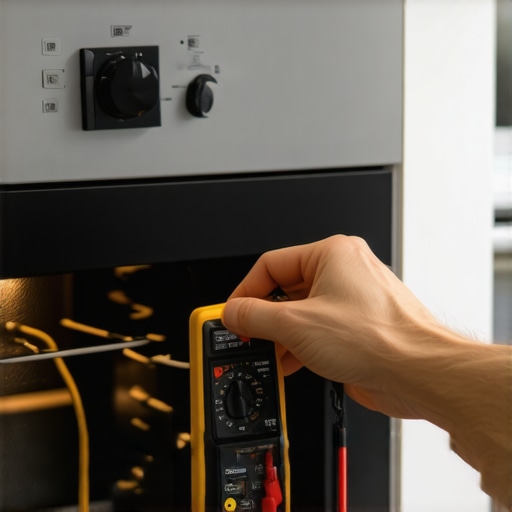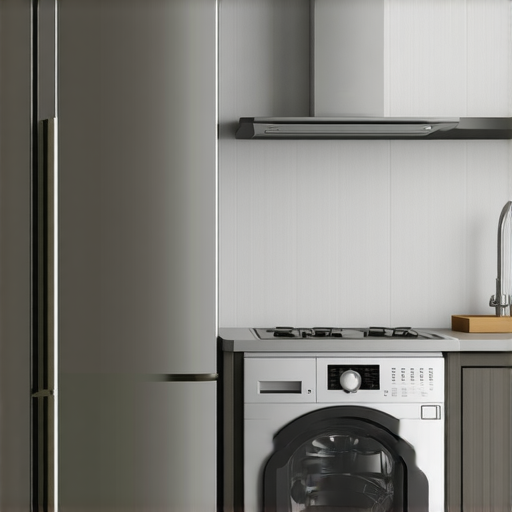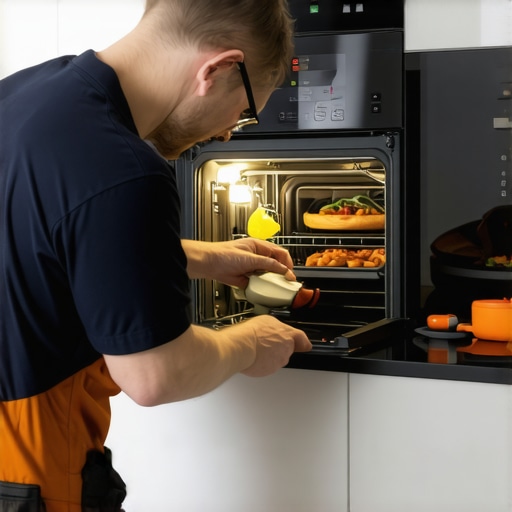My Unexpected Encounter with a Broken Oven
It all started when I was preparing a cozy dinner for my family, and suddenly, the oven refused to heat up. Frustration set in, but I realized this was my chance to dive into the world of oven repair. Over time, I learned that understanding common issues and diagnostics can make fixing an oven both quick and reliable.
Sharing My Top Oven Repair Tips & Diagnostics
One of the first lessons I picked up was the importance of identifying the root cause before rushing into repairs. For example, if your oven doesn’t heat, it might be a faulty heating element or a bad thermostat. I found that inspecting parts like the heating element and temperature sensor, using the guidance from this comprehensive parts guide, can streamline the troubleshooting process.
What Are the Common Signs That Indicate an Oven Needs Repair?
From my experience, uneven heating, clicking noises, or the oven not turning on are typical signs. I remember when my oven started making strange noises—initially I thought it was just a quirky sound, but it was a sign that a component was failing. Regularly checking elements like the heating coil or the control board can save you from bigger problems later on. For more detailed diagnostics, I recommend visiting this resource.
How Do I Quickly Diagnose Common Oven Problems?
Diagnosing an oven problem can seem daunting, but I’ve found that systematic testing makes it manageable. For example, using a multimeter to test the heating element’s continuity can reveal if it’s blown. Also, inspecting the oven’s fuse or circuit breaker can identify electrical issues. If you’re unsure, consulting with authoritative sources or professionals can be helpful. I often refer to this diagnostic guide for thorough step-by-step troubleshooting.
Why is Proper Diagnosis Crucial Before Replacing Parts?
Replacing parts without proper diagnosis can lead to unnecessary expenses and further damage. For example, replacing a heating element when the real issue is a faulty thermostat won’t solve the problem. Accurate diagnosis ensures you target the real cause, saving time and money. I’ve learned that patience and careful testing are key, and I encourage everyone to approach repairs with this mindset.
If you’ve ever faced stubborn oven issues, I’d love to hear your experiences. Share your stories or ask questions in the comments below—I believe that learning from each other makes us all better at DIY repairs!
Mastering the Art of Precise Oven Diagnostics: What Are the Hidden Signs?
As an appliance repair enthusiast, I’ve come to realize that many oven issues exhibit subtle signs that often go unnoticed until they become major problems. For instance, slight variations in baking times or inconsistent temperature readings can be early indicators of a malfunctioning thermostat or sensor. Recognizing these nuanced signals requires a keen eye and understanding of how different components work together. Regularly inspecting parts like the temperature sensor and control board using detailed diagnostics from this authoritative resource can help in catching issues before they escalate.
What Are the Most Overlooked Causes of Oven Failures?
Beyond the common culprits like heating elements and thermostats, I’ve found that electrical connections and circuit boards are often overlooked. Loose wiring or corroded contacts can disrupt power flow, causing intermittent heating or complete failure. In my experience, a thorough inspection of the wiring harness and control module can reveal hidden faults. For detailed guidance on electrical diagnostics, consulting this comprehensive guide is invaluable.
How Can I Safely Test My Oven’s Internal Components Without Damage?
Testing oven parts without causing damage requires proper tools and methodology. A multimeter is essential for checking continuity in heating elements and sensors, but knowing where and how to test is crucial. For example, disconnecting power before testing and ensuring the oven is cool prevents injury and inaccurate readings. When testing components like the fuse or control board, referencing authoritative troubleshooting guides can prevent misdiagnosis. For reliable diagnostics, I recommend reviewing detailed procedures at this resource.
Why Does Proper Component Identification Make All the Difference?
Misidentifying parts can lead to unnecessary replacements and prolonged downtime. For example, a faulty oven control board might mimic symptoms of a broken heating element. A precise diagnosis, aided by understanding the specific roles of components, saves both time and money. I’ve found that keeping a well-organized parts guide, like this essential parts list, helps me quickly pinpoint the issue.
If you have faced persistent oven problems despite replacing parts, I encourage you to share your experiences or ask questions. Your insights might help others avoid common pitfalls. Also, exploring related topics like dishwasher troubleshooting can broaden your appliance repair skills — check out this guide for more troubleshooting tips.

How Do I Detect Subtle Signs That Indicate a Deeper Oven Malfunction?
Over the years, I’ve realized that many oven problems don’t announce themselves loudly; instead, they whisper through minor irregularities. For instance, slight temperature inconsistencies during baking or unexpected delays in preheating can be early warnings of thermostat or sensor issues that aren’t immediately obvious. Recognizing these subtle cues requires a combination of attentive observation and a thorough understanding of how oven components interact. Regularly monitoring your oven’s performance and cross-referencing it with diagnostic guides, such as this resource, can help you catch issues before they escalate into costly repairs.
What Are the Overlooked Electrical Factors Causing Oven Failures?
In my experience, electrical connections often hide behind the scenes, silently sabotaging oven performance. Loose wiring, corroded contacts, or a failing control board can produce symptoms like intermittent heating or complete failure. These issues are easily overlooked because they lack the dramatic signs of a broken heating element. A meticulous inspection of wiring harnesses and circuit boards, guided by detailed diagnostics at this comprehensive guide, can reveal hidden faults that prevent your oven from functioning properly. Ensuring that all electrical connections are secure and free of corrosion can often restore reliable operation without costly part replacements.
How Can I Safely Test Internal Components Without Causing Damage?
Testing oven parts requires a careful approach—using the right tools and following proven procedures. I always disconnect power before beginning any inspection to avoid injury or further damage. A high-quality multimeter is essential for checking continuity in heating elements and sensors. When testing components like the fuse or control board, I consult authoritative troubleshooting guides to ensure I perform procedures correctly. For example, verifying the heating element’s resistance with a multimeter can confirm whether it’s blown or still functional. Proper testing not only prevents unnecessary replacements but also provides peace of mind that you’ve accurately diagnosed the problem. For detailed testing steps, I recommend reviewing this resource.
Why Is Precise Component Identification Critical for Successful Repairs?
Misdiagnosing a component can lead to wasted money and prolonged downtime. For example, a failing control board may mimic the symptoms of a faulty heating element, but replacing the wrong part doesn’t solve the real issue. Accurate identification of the problematic component, supported by a good parts guide like this essential parts list, streamlines repairs and reduces costs. I’ve learned that taking the time to verify each part’s function is invaluable. This approach not only saves money but also extends the lifespan of your oven by preventing unnecessary replacements.
If you’ve faced complex oven issues that weren’t straightforward to diagnose, I’d love to hear your stories or questions. Sharing experiences helps us all learn and refine our troubleshooting skills. Feel free to comment below or explore related topics like dishwasher troubleshooting at this guide to broaden your appliance repair knowledge.
What Are the Hidden Signs of Overlooked Causes of Oven Failures?
Beyond the obvious culprits, electrical wiring issues and circuit board faults often cause persistent oven problems. Loose or corroded wiring can intermittently disrupt power, leading to inconsistent heating or complete failure. In my experience, a careful inspection of wiring connections and control modules can uncover these hidden faults. For detailed guidance, I turn to this authoritative resource, which provides step-by-step procedures to diagnose electrical faults safely. Regularly checking and securing wiring connections is a simple yet effective way to maintain oven reliability.
How Do I Avoid Damage When Testing Internal Components?
Proper testing techniques are crucial to prevent damage and ensure accurate results. I always disconnect power before testing and use a multimeter to check resistance and continuity. It’s important to understand the specific testing points for each component—consulting detailed guides can prevent misdiagnosis. For example, testing the oven’s fuse or control board requires patience and precision. When in doubt, seeking professional assistance or referring to trusted diagnostic resources like this guide can save you from costly mistakes.
How Does Accurate Component Identification Impact Long-Term Oven Performance?
Identifying the right component not only solves immediate issues but also preserves your oven’s long-term health. Incorrect replacements can mask underlying problems or cause collateral damage. For example, replacing a control board without confirming it’s the root cause might lead to recurring failures. I’ve found that a thorough understanding of each part’s role—supported by reliable parts guides—ensures that repairs are effective and durable. This meticulous approach ultimately saves money, time, and frustration, helping your oven serve reliably for years to come.

Deciphering the Subtle Clues of Oven Malfunctions Through Advanced Diagnostics
Over the years, my journey into oven repair has revealed that many issues manifest through nuanced signs that demand a discerning eye. For example, slight fluctuations in preheating times or inconsistent baking results often hint at deeper problems within the thermostat or sensor calibration. These subtle cues require a combination of meticulous observation and a solid understanding of component interactions. Regularly logging your oven’s performance metrics, such as temperature stability over multiple cycles, can help identify patterns that precede more severe failures. Consulting authoritative diagnostic resources, like this comprehensive guide, can equip you with the skills to interpret these minor irregularities effectively.
Electrical Anomalies That Often Go Unnoticed but Cause Major Disruptions
Electrical issues, particularly loose or corroded wiring and faulty control boards, represent some of the most overlooked yet impactful causes of oven failure. These faults may produce intermittent heating or complete shutdowns, often without obvious signs. In my experience, a detailed inspection of wiring harnesses and circuit connections, guided by step-by-step diagnostics available at this resource, can reveal hidden faults. Ensuring that all electrical contacts are secure and free from corrosion not only restores functionality but also prevents future breakdowns. Remember, a careful visual and multimeter-based inspection can uncover these silent saboteurs that compromise your oven’s reliability.
Advanced Testing Techniques to Safeguard Your Components from Damage
When testing internal oven components, employing precise and cautious techniques is paramount. I always disconnect power before conducting any inspections to avoid injury or further damage. Using a multimeter, I verify the resistance in heating elements and sensors, paying close attention to manufacturer specifications. For delicate parts like the control board or fuse, I follow detailed troubleshooting procedures outlined in trusted guides, such as this authoritative source. Proper testing not only prevents unnecessary replacements but also ensures you accurately diagnose the root cause, saving time and money in the long run. Remember, patience and adherence to safety protocols are your best allies during these procedures.
How Can I Leverage My Experience to Prevent Future Oven Failures?
Sharing your personal experiences and insights can significantly benefit fellow DIY enthusiasts. Reflecting on specific cases where subtle signs led to successful repairs or where overlooked electrical issues caused persistent failures helps create a valuable knowledge base. I encourage you to document your troubleshooting steps, note the signs you observed, and compare them with expert diagnostics. Engaging with online communities or blogs dedicated to appliance repair not only broadens your understanding but also keeps you updated on emerging issues and solutions. Your real-world stories can inspire others to approach repairs with confidence and a keen eye for detail. Feel free to share your experiences or ask questions—collective learning enriches us all!
Uncovering Hidden Signs of Deep-Seated Oven Problems with Precision Observation
Many oven failures hide behind seemingly minor irregularities that can be easily dismissed. For instance, subtle temperature drifts during baking cycles or slight delays in reaching preheat temperature often point to calibration issues or sensor misalignments. Recognizing these signs requires a combination of attentive monitoring and an understanding of component interactions. Regular performance audits, such as tracking temperature consistency and preheat durations, can help catch issues early. Consulting detailed diagnostic guides like this resource enables you to interpret these signals accurately, preventing minor problems from escalating into costly repairs.
Electrical Faults That Often Remain Hidden but Sabotage Oven Performance
Electrical connections, especially wiring harnesses and control modules, are frequently the silent culprits behind persistent oven issues. Loose or corroded contacts can cause intermittent power delivery, leading to inconsistent heating or total failure. In my experience, a meticulous inspection of wiring connections, combined with effective use of diagnostic tools, reveals these hidden faults. For detailed guidance, I rely on this comprehensive guide. Securing all electrical contacts and ensuring they are free from corrosion can restore consistent performance and extend your oven’s lifespan. Remember, electrical troubleshooting demands patience and precision—approach it systematically for the best results.
Safeguarding Internal Components: Best Practices for Accurate Testing
To prevent damage while testing internal oven components, I emphasize following strict safety protocols. Always disconnect power and handle components with care. Using a multimeter, I check for continuity and resistance, paying attention to testing points specified in authoritative troubleshooting guides. For example, verifying the fuse or control board resistance requires patience and a steady hand. When in doubt, consulting detailed diagnostic resources like this guide can prevent costly errors. Proper testing techniques not only protect your components but also ensure you diagnose issues accurately, saving time and money in repairs.
The Long-Term Impact of Accurate Component Identification on Oven Reliability
Correctly identifying faulty components is essential for durable repairs. A misdiagnosis can lead to unnecessary replacements and recurring problems. For instance, replacing a control board without confirming it’s the root cause might mask underlying wiring faults. My approach involves cross-referencing symptoms with detailed parts guides like this resource, ensuring each repair targets the true issue. This meticulous process not only enhances the longevity of your oven but also optimizes your repair budget. Remember, precision in component identification is the cornerstone of reliable, long-term appliance performance.
Things I Wish I Knew Earlier (or You Might Find Surprising)
The Subtle Signs Are Often the Most Important
Early in my DIY repair journey, I underestimated how small irregularities like slight temperature fluctuations could hint at deeper issues. One time, I ignored minor preheat delays, only to find out later that it was a sign of sensor misalignment. Paying close attention to these tiny clues can save you from bigger headaches down the line.
Electrical Connections Are Often the Culprits
Many times, I’ve discovered that loose wiring or corroded contacts cause intermittent heating problems, even when the main parts seem fine. A thorough visual inspection of wiring harnesses and connectors, guided by trusted diagnostics, can reveal hidden faults that are easy to overlook.
Proper Diagnosis Saves Time and Money
Jumping straight to replacing parts without proper testing can lead to unnecessary expenses. Using tools like a multimeter to check continuity and resistance, following reliable guides, ensures you target the real issue, making repairs more effective and less costly.
Patience Is Key During Troubleshooting
Rushing through diagnostics often results in misdiagnosis. Taking your time to systematically test each component and cross-referencing with trusted resources helps ensure you don’t replace the wrong parts and prolong the repair process.
Safety First — Always Disconnect Power
Before testing or inspecting internal components, disconnecting the oven from power is crucial. This simple step prevents injury and protects your components from accidental damage, making your repair safer and more reliable.
Resources I’ve Come to Trust Over Time
- Appliance Bargainz Repair Guides: Their comprehensive diagnostics and parts guides have been invaluable in understanding complex issues. I highly recommend their detailed resources for both beginners and experienced DIYers.
- YouTube Repair Channels: Watching experienced technicians troubleshoot in real-time has improved my diagnostic skills immensely. It’s a great way to visualize complex procedures and safety tips.
- Manufacturer Service Manuals: Whenever possible, I consult official manuals for specific models. They provide precise wiring diagrams and troubleshooting steps that are trustworthy and detailed.
Parting Thoughts from My Perspective
From my personal experience, mastering oven diagnostics requires patience, attention to detail, and a willingness to learn from mistakes. Recognizing subtle signs and understanding electrical nuances have transformed how I approach repairs. Remember, accurate diagnosis is the foundation of a successful fix — rushing into replacements rarely leads to a durable solution. If this resonated with you, I’d love to hear your thoughts or stories about your own appliance repair adventures. Sharing our experiences helps us all become better at troubleshooting and fixing our appliances efficiently. Feel free to drop your comments below or explore related topics like dishwasher troubleshooting at this guide to deepen your knowledge. Happy fixing!”},

